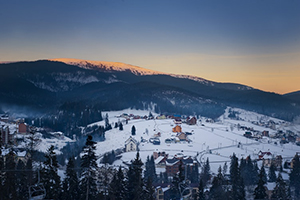21.4 Present Tense of Verbs (Бути)

In this module, you will learn when and how to use the verb бу́ти (to be), which also belongs to the first conjugation, in the infinitive and in the present tense.
Завдання 1
Mark all the verbs in the dialogue below between two people vacationing in the Carpathian Mountains. Then answer the questions that follow.

Ціка́во!
The verb бу́ти, when conjugated, takes the hard-vowel endings of the first conjugation, like the verbs писа́ти and жи́ти (я бу́ду…). However, the conjugated forms of this verb have future meaning. In the present tense, this verb only has one form, є. Є is used in all persons and is equivalent to the English “am,” “is,” or “are.” For example:
Тут є моро́зиво? (Is there ice-cream here?)
Там є смачні́ торти́. (There are tasty cakes there.)
Most often in the present tense, however, є is not used but rather implied, as in the second line of the dialogue above, or in the following examples:
– Де ви? (Where are you?)
– Ми в кіно́. (We are at the movies.)
Є is only required in sentences about the existence of something, or what are “there is”/“there are” sentences in English. For example:
В університе́ті є бібліоте́ка. (There is a library at the university.)
Тут є чоти́ри ба́нки. (There are four banks here.)
Завдання 2
Complete the short exchanges below using the words from the bank.
Ціка́во!
Є is often used with the construction в/у + noun/pronoun in the genitive case. Such sentences express possession – but when translated literally, they are still about existence. Hence, the use of є. For example:
У ме́не є брат. (Literally: By me there is a brother. = I have a brother.)
В ма́ми є два комп’ю́тери. (Literally: By mom there are two computers. = Mom has two computers.)
As Module 21.1 showed, Ukrainian also has a regular verb that expresses possession – ма́ти. Sentences with the above construction and those with ма́ти are identical in meaning:
У ме́не є цуценя́. = Я ма́ю цуценя́.
В та́та є вели́кий рюкза́к? = Та́то ма́є вели́кий рюкза́к?
Note, however, that there can be contexts in which є is not required with the в/у construction of possession. Compare the question above with the following one, which is about the size of a backpack rather than its existence:
– В та́та вели́кий рюкза́к? – Ні, мале́нький.
See Module 7.1 for the в/у construction of possession with nouns and Module 13.3 for the same construction with pronouns.
Завдання 3
Provide the appropriate captions for the pictures below.
Важли́во!
Unlike with other verbs, to negate є, you need to use the form нема́є (or нема́ in less formal situations). For example:
– Тут є туале́т?
– Ви́бачте, нема́є. (Or: Нема́.)
Завдання 4
Select the most appropriate response to each of the questions below.
Важли́во!
In sentences that identify, define, or describe someone or something, є is implied rather than used explicitly:
Я студе́нтка. (I am a student.)
Мої́ батьки́ – інжене́ри. (My parents are engineers.)
Note how in the last sentence above, є is replaced with a dash. The dash is used when the subject of the sentence expressed by a noun (батьки́) is defined or described by means of another noun (інжене́ри). It is not used if one of these elements is a pronoun or an adjective, as in Я студе́нтка.
Завдання 5
Write down exactly what you hear below, including all punctuation. When using the dash (–), be sure to leave one space on either side of the dash.
Мо́вний пазл
Look through the activities you have just completed and choose the correct statements below to summarize what you have learned.
А тепе́р тест!
Complete the dialogue below by selecting the appropriate form of бу́ти. Select “-” where no verb form is needed.

